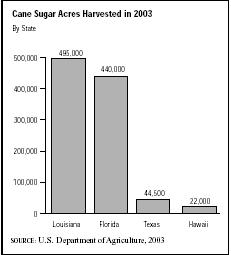SIC 2062
CANE SUGAR REFINING
This entry includes establishments primarily engaged in refining purchased raw cane sugar and sugar syrup. Sugar cane is cut and milled into raw cane sugar, then shipped in that form to refiners to be processed into syrup, granulated sugar, powdered sugar, or brown sugar. Establishments that manufacture the raw cane sugar from sugar cane are included under SIC 2061: Cane Sugar, Except Refining. Other products of the cane sugar refining process include blackstrap molasses and invert sugar.
NAICS Code(s)
311312 (Cane Sugar Refining)
The U.S. cane sugar refining industry has been facing heavy competition and increased economic challenges over the past two decades. However, the resulting shakeout and rationalization within the sector has managed to stabilize the situation, ensuring, at least in the short term, a viable future for a significantly streamlined industry. Manufacturers of beet sugar, high fructose corn syrup (HFCS), and artificial sweeteners have all taken a large share of the market away from cane sugar refiners. Industry shipments in 2001 were valued at $2.26 billion, compared to $3.18 billion in 1997.
Soft drink manufacturers switched to HFCS from liquid cane sugar in the 1980s, striking a severe blow to the sugar industry. Per capita consumption of sugar (both beet and cane) plummeted from 1970, when it stood at roughly 102 pounds, to 1980, when it stood at about 60 pounds. By 2002 it had fallen to 45 pounds. This steady drop in consumption led to a reduction in cane sugar refineries, from 22 in 1981 to just 12 at the turn of the twenty-first century. To compensate for the losses, cane sugar refiners diversified, adding sugar beet processing operations and/or wet-milling operations to produce HFCS and other corn sweeteners.
In addition to the rise in HFCS, cane sugar refiners faced other problems as well. Domestic production of sugar cane dropped, and a strict quota on imported raw cane sugar was imposed by the federal government. The drop in availability of imported raw sugar was especially serious to the industry since sugar refineries in the United States processed more imported raw sugar than domestically-milled raw sugar.
Along with new product competition, price plagued the cane sugar refining industry in the 1990s and 2000s. Federal programs kept the price of domestic sugar higher than world market prices. In 1992, for example, when the world price of sugar was 10 cents a pound, the price in the

United States was 21 cents a pound. The government also imposed a quota to prevent cheaper imported sugar from flooding the U.S. market, although the United States continued to import some raw sugar because it did not grow enough to meet U.S. demand. As a result, prices for sugar have traditionally gone through dramatic swings, and this trend has continued into early 2000s as the price per bushel of cane sugar jumped from $26.10 in 2000 to $29 in 2001.
High fructose corn syrup producers have been able to undercut the sugar market—both beet sugar and cane sugar—make HFCS a cheaper alternative sweetening agent for processed foods. Americans consumed more corn syrup than refined sugar in the early 2000s, particularly in soft drinks. The beverage industry is said to be a primary force behind the demise of cane sugar production. Coca-Cola was the largest sugar buyer in the United States in the 1980s, accounting for 10 percent of the market.
At least one market continued to prefer cane sugar to its competitors. Candy and pastry makers were not impressed with substitutes for refined cane sugar. They insisted that beet sugar was not suitable for their purposes and that they achieved better results with pure cane sugar. According to the U.S. government, however, cane sugar and beet sugar have the same chemical formula so refiners cannot claim any difference between them.
To produce refined sugar from raw sugar, the raw sugar crystals are transported, aboard ships or trains to refineries where first the yellow-brown film is rinsed off. The sugar crystals are dissolved in water and poured through a series of filters until the liquid is clear. The syrup is heated so the liquid evaporates leaving crystals again. The crystals are spun in a centrifuge, and then the white sugar is separated into a drying drum where any remaining moisture is eliminated. Syrup that does not form crystals is used to make brown sugar. Molasses is another by-product of the refining process.
One of the most significant developments in cane sugar refining business came in late 1997 when Imperial Holly Corp. and Savannah Foods and Industries Inc. merged to create the largest domestic refiner and processor of sugar. The resulting company was renamed Imperial Sugar Co. The company operates four cane sugar refineries, as well as a number of beet sugar facilities. With a 25 percent share of the U.S. sugar market, the company markets sugar products under a variety of brand names, including Imperial, Dixie Crystals, Pioneer Sugar, Holly Sugar, Spreckels Sugar, and Diamond Crystal. Imperial Sugar filed for Chapter 11 bankruptcy protection in 2001 while it paid down its mounting debt by divesting certain assets. Sales in 2003 declined 14 percent to $1.1 billion, although earnings increased 367 percent to $77 million.
Tate and Lyle North American Sugars, a subsidiary of London-based Tate and Lyle PLC, accounted for about 20 percent of the U.S. sugar market, marketing the bestselling Domino brand sugar products. In addition to refining cane sugar, Tate and Lyle processed beet sugar as well. However, in 2001, Tate and Lyle sold the Domino sugar brand to the Sugar Cane Growers Cooperative of Florida and the Florida Crystals Corp. for $180 million. The new joint venture was dubbed Domino Sugar.
Further Reading
U.S. Department of Agriculture. "Sugar and Sweeteners." Washington, DC: 12 January 2004. Available from http://usda.mannlib.cornell.edu/reports/nassr/field/pcp-bba/acrg0603.txt .
U.S. Department of Agriculture. Track Records of U.S. Crop Production. Washington, DC: 2003. Available from http://usda.mannlib.cornell.edu/data-sets/crops/96120/track03d.htm .
Comment about this article, ask questions, or add new information about this topic: